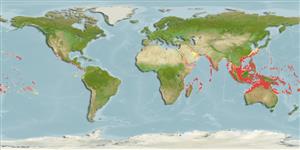>
Acanthuriformes (Surgeonfishes) >
Chaetodontidae (Butterflyfishes)
Etymology: Heniochus: Greek, enioi, -ai, -a = sometimes, some + Greek, oche = food (Ref. 45335).
More on authors: Smith & Radcliffe.
Environment: milieu / climate zone / rango de profundidad / distribution range
Ecología
marino asociado a arrecife; rango de profundidad 2 - 250 m (Ref. 90102), usually 15 - 40 m (Ref. 9710). Tropical; 32°N - 23°S
Pacific Ocean: Andaman Islands in the eastern Indian Ocean to Samoa, north to southern Japan, south to Rowley Shoals and New Caledonia.
Tamaño / Peso / Age
Madurez: Lm ? range ? - ? cm
Max length : 30.0 cm TL macho / no sexado; (Ref. 48636)
Espinas dorsales (total) : 11 - 12; Radios blandos dorsales (total) : 25 - 27; Espinas anales: 3; Radios blandos anales: 17 - 18.
Body shape (shape guide): short and / or deep; Cross section: compressed.
An uncommon species (Ref. 9710) that inhabits deep lagoon and seaward reefs. Adults solitary or in small groups and prefer areas with rich coral growth and high vertical relief (Ref. 1602). Juveniles solitary and secretive on inshore reefs. Largest of the bannerfishes (Ref. 48636). Feed on coral polyps (Ref. 9710). Oviparous (Ref. 205). Form pairs during breeding (Ref. 205).
Life cycle and mating behavior
Madurez | Reproducción | Puesta | Huevos | Fecundidad | Larva
Form pairs during breeding (Ref. 205).
Randall, J.E., G.R. Allen and R.C. Steene, 1990. Fishes of the Great Barrier Reef and Coral Sea. University of Hawaii Press, Honolulu, Hawaii. 506 p. (Ref. 2334)
IUCN Red List Status (Ref. 130435: Version 2024-2)
Threat to humans
Harmless
Human uses
Pesquerías: escaso valor comercial; Acuario: Comercial
Herramientas
Special reports
Download XML
Fuentes de Internet
Estimates based on models
Preferred temperature (Referencia
123201): 25 - 29, mean 28.1 °C (based on 840 cells).
Phylogenetic diversity index (Referencia
82804): PD
50 = 0.5039 [Uniqueness, from 0.5 = low to 2.0 = high].
Bayesian length-weight: a=0.01995 (0.00906 - 0.04395), b=3.01 (2.83 - 3.19), in cm total length, based on all LWR estimates for this body shape (Ref.
93245).
Nivel trófico (Referencia
69278): 3.6 ±0.44 se; based on food items.
Resiliencia (Referencia
120179): Alto, población duplicada en un tiempo mínimo inferior a 15 meses (Preliminary K or Fecundity.).
Fishing Vulnerability (Ref.
59153): Low vulnerability (20 of 100).
🛈
Nutrients (Ref.
124155): Calcium = 56.1 [28.3, 91.8] mg/100g; Iron = 0.628 [0.373, 1.013] mg/100g; Protein = 18.7 [17.6, 19.9] %; Omega3 = 0.138 [0.083, 0.228] g/100g; Selenium = 48.2 [26.8, 87.9] μg/100g; VitaminA = 45.8 [13.1, 156.3] μg/100g; Zinc = 0.996 [0.682, 1.426] mg/100g (wet weight);
